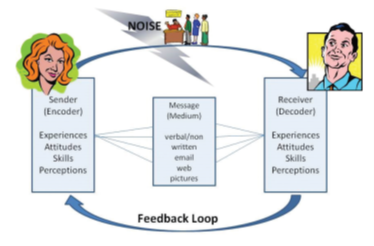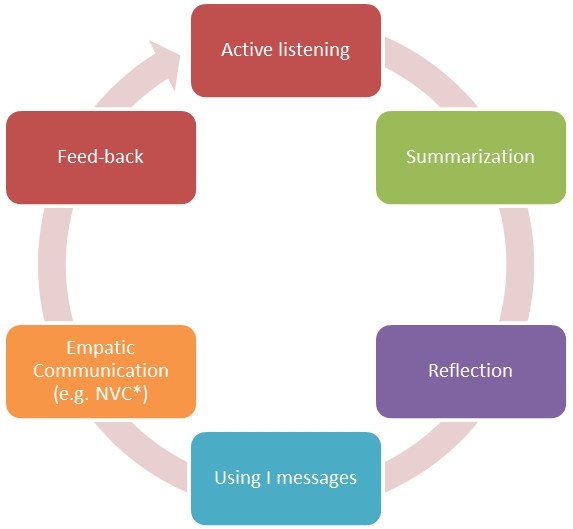Communication with other people is an integral and indispensable part of human life. It is an important activity of every individual since we establish relationships through communication. Communication helps us establish contacts, interpersonal relations and relationships, either social, familial or business. In interpersonal relationships, people, through communication, take turns in passing on experiences and learning from one other.
The term communication means a process whereby information and thoughts are transmitted and exchanged. Communication allows people to convey their feelings, thoughts, opinions and expectations.
There is verbal communication, which is communication through words, and non-verbal, which is communication that applies to facial expressions, movement, thoughts and feelings.
There is also a learning process which happens in communication; it means that in conversing with others we acquire new knowledge and skills and are exposed to new viewpoints. Communication, therefore, is not just a means with which to convey information but the main objective is for the information to be heard, understood, accepted and practically applied.
Communication process
Communication is a two-way process that results in a shared meaning or common understanding between the sender and the receiver

Communication is a two-way process that results in a shared meaning or common understanding between the sender and the receiver.
The efficient exchanging of information is a skill that requires systematic preparation. Using only speech is not enough, so we need to supplement the message with pictures, drawings and also a number of senses. This type of communication will then be more convincing, the co-speaker will remember it more easily, and it will be better accepted. This is necessary because people are different and we perceive information differently (e.g. information from the environment is accepted through our five (5) senses – visual, auditory, kinesthetic, olfactory, gustatory).
Efficient communication is achieved when we accept co-speakers as equals and especially when we respect ourselves and can objectively value ourselves in our environment. With active listening, the listener wishes to understand the co-speakers’ feelings and expectations; s/ he wants to understand the co-speakers point of view and doesn't judge the information. The manner of delivery and speaking is very important because it encompasses 45% of the message perceived by the participants. Communication skills also include the ability to manage time - the speaker is the one who controls the time, not the listeners.
For effective communication it is important to know the following:
WHO you are communicating with (it is of great importance to know your audience: who they are, what their age range is, what they already know, how many people will receive your message, etc.)
WHAT you are communicating – the communication should be relevant to the subject;
WHY - what the goal of your communication is, what you want to achieve;
WHEN you will communicate the issue;
HOW will you communicate the issue – think about the method you will choose.
For successful communication it is important to follow these guidelines:
Difficult Conversations
A difficult conversation is anything you find hard to talk about. These are conversations that touch on subjects of TRAUMA, HEALTH, RACE, SEXUALITY, POLITICS, RELIGION, GENDER, etc. These are sensitive subjects that can make a person vulnerable - the conversations can be difficult and they require many skills and abilities to deal with them successfully. People should not be afraid of difficult conversations although they present a dilemma: to avoid THEM or to confront with them?
Within difficult conversations there are three different stages we should be aware of and go through:
First stage - WHAT HAPPENED?
At this stage we need to be mindful of three elements: TRUTH, INTENTION AND BLAME. People get stuck on these points during the conversation and jump to conclusions which lead to conflict.
1. The truth assumption
During a conversation we can get trapped in contrasting claims: I am right, you are wrong. ‘I am right’ sentences are endless BUT everything that concerns the debate ‘Am I right’ concerns our beliefs, understanding and values. ‘I am right’ sentences tell us only how we ourselves create the meaning of something and that it does not have any connection with reality. Another person will have their own, completely different reality about the same problem because they interpreted the problem in their own way.
2. The intention invention
For this point we deal with the question of intent. Did the person shout at me because they wanted to hurt me or because they wished to more clearly express their opinion? How we understand the intentions of the other person influences the conversation itself. The problem that occurs at this stage is that we believe we know what intentions the other person has. We jump to conclusions, again.
3. The blame frame
People often react in this way when they try to absolve themselves of guilt and pass the blame on to another person, situation or another reason. By not judging we gain more time to focus on the real cause of the problem.
Second stage: THE FEELINGS CONVERSATION: WHAT SHOULD WE DO WITH OUR EMOTIONS?
How do we face and control emotions that appear during difficult conversations? People often decide not to talk about their feelings. They are afraid of the reaction, they do not know how to express themselves, and they are afraid that they will be rejected. But the essence of difficult conversations are feelings. Understanding emotions, talking about them, controlling and valuing them are the basic elements of important and difficult conversations.
Third stage: THE IDENTITY CONVERSATION: WHAT DOES THIS SAY ABOUT ME?
At this stage, the questions are: how does the existing problem influence me as a person and what does that say about me? Inside a difficult conversation a separate monologue occurs that revolves around identity – what do I say to myself during a difficult conversation? Internal dialogue will always occur. It is important that we are aware of it and that we try to balance it. If it goes out of control it can trap us and we become the prisoners of our own thoughts. It is important to have positively oriented and empowering thoughts and beliefs but still not in terms of avoidance yet not in terms of avoidance or self-repression. Therefore, a broader insight is needed.
In the field of providing psychosocial support and assistance, there are some important elements that make sense to consider in this process.
Reflection is a purposeful thoughtful activity which:
• contains reflections on concrete experiences;
• means looking back on the whole process;
• allows the person to gain new insights, new ideas, and acquire new understanding;
• is the process where basic insights and understanding of past events are formed;
• is an activity where the person search for new solutions;
• allows a person to test the selected solution in a new situation.
The stages of reflection are: 1) description of the event; 2) Feeling; 3) Evaluation; 4) Analysis; 5) Conclusion.
The importance of communication circle and helping professions
In order to make communication as successful as possible (including the bases described above) in the field of helping professions or sectors (such as volunteering), it makes sense to use the so-called communication circle with the described successive stages.

*NVC – Non-violent Communication by author Marshal B. Rosenberg.
The impact of pandemic crisis on vulnerable groups would rely in part on the quality of communication regarding health risk, mental health stability and danger. Concrete communication is proactive, imaginative, compassionate, innovative, creative, constructive, progressive, enabling, transparent and technology friendly. However, there are multiple factors playing a key role in accepting information, like social and cultural characteristics, gender, generational contrasts, language inclinations, strict convictions, religious beliefs, and varying literacy influence the action and behavour of individuals.